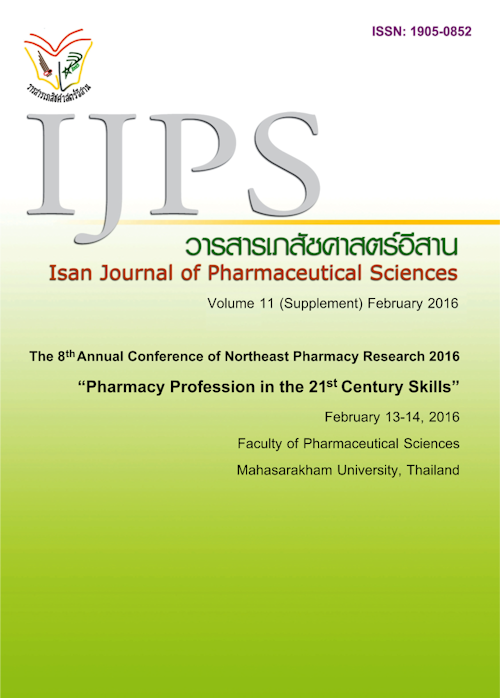A Systematic review and Meta-analysis efficacy of Gynostemma pentaphyllum (Thunb.) Markino on Blood glucose, lipid profile, blood pressure and anthropometric parameters
Main Article Content
Abstract
Introduction: Cardiovascular disease caused by hyperglycemia, hyperlipidemia hypertension and obesity. Gynostemma pentaphyllum is a medicinal plant which has reportedly affected on blood glucose, lipid profile lowering, decrease blood pressure and decrease anthropometric parameters. However, there were no clearly clinical efficacy evidences of G. pentaphyllum. The objectives of this study wereto review literatures systematically and conduct the meta-analysis to confirm clinical efficacy of G. pentaphyllum. Methods: Published articles were searched from electronic databases including Pubmed, Science-Direct, Scopus, SciSearch and ThaiLIS as well as hand search. Studies with randomized controlled trial design in human, written in English or Thai, and conducted until 2015 were recruited into the study. Two independent authors evaluated title, abstract, quality of studies and extract data. Results: Four publications met inclusion criteria with high quality of methodology with Jadad’s score. The number of participants in the studies ranged from 16-80. Three studies were conducted in Vietnam and one study was performed in South Korea. The resulted showed statistically significant difference of efficacy in glycemic control between G. pentaphyllum and comparators; FBS (WMD -1.17 mmole/L; 95%CI -1.63, -0.71; p<0.001), HbA1c (WMD -1.10%; 95%CI -1.61, -0.59; p<0.001), HOMA-IR (WMD -2.21; 95%CI -4.36, -0.07; p=0.04). There were no statistically significant differences in blood lipid, blood pressure, and anthropometric parameters. No serious ADR from G. pentaphyllum had been found during the studies. Conclusion: This study suggests that G. pentaphyllum expresses blood glucose lowering effect. This suggests that G. pentaphyllum can be used as an alternative for glycemic control. However, the adverse side effect and safety should be concerned and a randomized control trial is stillneeded in order to confirm other clinical outcomes and safety of G. pentaphyllum.
Article Details
In the case that some parts are used by others The author must Confirm that obtaining permission to use some of the original authors. And must attach evidence That the permission has been included
References
Chapman MJ, Ginsberg HN, Amarenco P, et al. Triglyceride - rich lipoproteins and high-density lipoprotein cholesterol in patients at high risk of cardiovascular disease: evidence and guidance for management. Eur Heart J2011; 32:1345-1361.
Cui JF, Eneroth P, Bruhn JG. Gynostemma pentaphyllum: identification of major sapogenins and differentiation from Panax species. Eur J Pharm Sci 1999; 8:187-191.
Davidson JA, Parkin CG. Is hyperglycemia a causal factor in cardiovascular disease? Diabetes Care2009; 32: s331-333
Huyen VTT, Phan DV, Thang P, Hoa NK, Ostenson CG. Antidiabetic effect of Gynostemmapentaphyllumtea in randomly assigned type 2 diabetic patients. Horm Metab Res2010; 42(5):353-7
Huyen VTT, Phan DV, Thang P, Ky PT, Hoa NK, Ostenson CG. Antidiabetic Effects of Add-On Gynostemmapentaphyllum Extract Therapy with Sulfonylureas in Type 2 Diabetic Patients. Evid Based Complement Alternat Med 2012; 2012: 452313. doi: 10.1155/2012/452313.
Huyen VTT, Phan DV, Thang P, Hoa NK, Ostenson CG. Gynostemmapentaphyllum Tea Improves Insulin Sensitivity in Type 2 Diabetic Patients. J NutrMetab 2013; 2013: 765383. doi: 10.1155/2013/765383.
Higgins JPT, Thomson SG, Deeks JJ, Altman DG. Measuring inconsistency in meta-analyses. BMJ2003; 327:557-60.
Jadad AR, Moore RA, Carroll D, Jenkinson C, Reynolds DJ, Gavaghan DJ, McQuay HJ. Assessing the quality of reports of randomized clinical trials: Is blinding necessary? Control Clin Trials1996; 17:1-12.
Li B, Zhang XY, Wang MZ, Jiao LL. Characterization and antioxidant activities of acidic polysaccharides from Gynostemmapentaphyllum(Thunb.) Markino. Carbohydr Polym 2015; 127:209-14.
Megalli S, Aktan F, Davies NM, Roufogalis BD. Phytopreventative anti-hyperlipidemic effects of Gynostemmapentaphyllumin rats. Pharm PharmSci 2005; 8(3): 507-15.
Megalli S, Davies NM, Roufogalis BD. Anti-hyperlipidemic and hypoglycemic effects of Gynostemmapentaphylluminthe Zucker fatty rat. J Pharm PharmSci2006;9(3):281-91.
Mishra RN, Joshi D. Jiao Gu Lan (Gynostemmapentaphyllum): The Chinese Rasayan-Current Research Scenario. IJRPB2011; 2(4): 1483-1502.
Park SH, Huh TL, Kim SY, Oh MR, TirupathiPichiah PB, Chae SW, Cha YS. Antiobesity effect of Gynostemmapenta phyllumextract (actiponin): a randomized, double-blind, placebo-controlled trial. Obesity 2014;22(1):63-71.
Petitti DB. Meta-analysis decision analysis and cost effectiveness analysis. 2nded. Oxford University; New York; 2000.
Sahebkar A. A systematic review and meta-analysis of randomized controlled trials investigating the effects of curcumin on blood lipid levels. ClinNutr 2014; 33(3): 406-14.
Shishtar E, Sievenpiper JL, Djedovic V, Cozma AI, Ha V, Jayalath VH, et al., The effect of ginseng (the genus panax) on glycemic control: a systematic review and meta-analysis of randomized controlled clinical trials. PLoS One2014; 9(9): e107391. doi: 10.1371/journal.pone.0107391. e Collection 2014.
WHO.Cardiovascular diseases (CVDs), Fact Sheet, 2009. http://www.who.int/mediacentre/factsheets/fs317en/. Accessed August 15, 2015.
Wu T, Fu J, Yang Y, Zhang L, Han J. The effects of phytosterols/stanols on blood lipid profiles: a systematic review with meta-analysis. Asia Pac J Clin Nutr 2009 18:179-186.
Yassin K, Huyen VT, Hoa KN, Ostenson CG. Herbal Extract of Gynostemma Pentaphyllum Decreases Hepatic Glucose Output in Type 2 Diabetic Goto-Kakizaki Rats. Int J Biomed Sci 2011; 7(2): 131-136.
Yaron A. Characterization of aloe vera gel before and after autodegradation, and stabilization of the natural fresh gel. Phytother Res1993; 7: S11–13.


